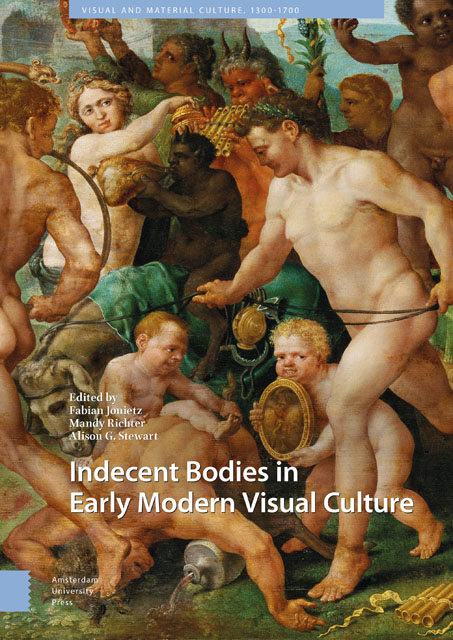Book contents
- Frontmatter
- Table of Contents
- List of Illustrations
- Indecent Bodies in Early Modern Visual Culture: An Introduction
- 1 Taste, Lust, and the Male Body: Sexual Representations in Early Sixteenth-Century Northern Europe
- 2 Private Viewings: The Frankfurt Context of Sebald Beham’s Die Nacht
- 3 To Show or Not to Show? Marcantonio Raimondi and the Representation of Female Pubic Hair
- 4 Treating Bodily Impurities: Skin, Art, and Medicine
- 5 Indecent Exposure and Honourable Uncovering in Renaissance Portraits of Women
- 6 Lust in Translation: Agency, Sexuality, and Gender Configuration in Pauwels Franck’s Allegories of Love
- 7 ‘So this guy walks into a forest…:’ obscenity, humour, sex, and the equine body in hans baldung’s Horses in a forest woodcuts (1534)
- 8 Indecent Creativity and the Tropes of Human Excreta
- 9 ‘It All Turns to Shit’ – The Land of Cockaigne in Sixteenth-Century German Woodcuts
- 10 Noëls and Bodily Fluids: The Business of Low-Country Ceremonial Fountains
- Index
8 - Indecent Creativity and the Tropes of Human Excreta
Published online by Cambridge University Press: 19 April 2023
- Frontmatter
- Table of Contents
- List of Illustrations
- Indecent Bodies in Early Modern Visual Culture: An Introduction
- 1 Taste, Lust, and the Male Body: Sexual Representations in Early Sixteenth-Century Northern Europe
- 2 Private Viewings: The Frankfurt Context of Sebald Beham’s Die Nacht
- 3 To Show or Not to Show? Marcantonio Raimondi and the Representation of Female Pubic Hair
- 4 Treating Bodily Impurities: Skin, Art, and Medicine
- 5 Indecent Exposure and Honourable Uncovering in Renaissance Portraits of Women
- 6 Lust in Translation: Agency, Sexuality, and Gender Configuration in Pauwels Franck’s Allegories of Love
- 7 ‘So this guy walks into a forest…:’ obscenity, humour, sex, and the equine body in hans baldung’s Horses in a forest woodcuts (1534)
- 8 Indecent Creativity and the Tropes of Human Excreta
- 9 ‘It All Turns to Shit’ – The Land of Cockaigne in Sixteenth-Century German Woodcuts
- 10 Noëls and Bodily Fluids: The Business of Low-Country Ceremonial Fountains
- Index
Summary
Abstract
This essay explores depictions and descriptions of bodily excretion inlight of theories of creativity and artistic practices. References tophysical effluxes and excretions by early seventeenth-century Northernpainters, I argue, pursue sixteenth-century concepts which connect lowerbody parts and physical activities to visual perception and humanproduction. The visual arts were inclined to reflect on such ideas notonly because of ubiquitous metaphors comparing the absorption ofintellectual matter and their subsequent mental digestion to theconversion of food, but also because waste products had a fundamentalrole in artist's workshops. The dual quality of excrements asindecent waste and as fertilising manure was predestined to mirrorconcepts of imitation, and lead to a reconsideration of the generalrelation of artworks to the products of nature.
Keywords: Galaton; Gegorio Leti; Peter Flotner; scatology;Sebastian Stoskopff; urination
The publication of David Foster Wallace's The SufferingChannel in 2002 most likely marks the very moment when the artworld became saturated by scatological artworks: sculptures and paintingsthematising excrement had become a conceptual genre in their own right,making it necessary to address this class of artworks in yet a differentgenre ‒ literature.
In fact, Wallace wrote the novella at a time when ‒ with the exceptionof Wim Delvoye's startling Cloaca (2000) ‒highly promoted artworks such as Marc Quinn’s ShitHead and Shit Paintings (1997/1998) and theoeuvre of Andres Serrano had successfully capitalised on these ideas, andhad been feeding the mainstream art market with blunt reinterpretations ofprovocations raised decades earlier, for instance by Andy Warhol'sOxidation Paintings (1977/1978), Paul McCarthy'sShitFace Painting (1974), and especially by PieroManzoni's multiple Merda d’artista (1961).Yet, the continued success of the genre proves that the perception of humanexcretion as indecent had not changed over time. The SufferingChannel revolves once again around the question of decency: thestory narrates a journal's difficulties in publishing an article onthe fecal creations of a fictive sculptor, Brint Molke, and theartist's shy resistance to publicity, which results in a distressingperformance of his art of defecation, and eventual death.
- Type
- Chapter
- Information
- Indecent Bodies in Early Modern Visual Culture , pp. 197 - 228Publisher: Amsterdam University PressPrint publication year: 2022

